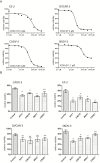MEK1 is associated with carboplatin resistance and is a prognostic biomarker in epithelial ovarian cancer
- PMID: 25408231
- PMCID: PMC4247127
- DOI: 10.1186/1471-2407-14-837
MEK1 is associated with carboplatin resistance and is a prognostic biomarker in epithelial ovarian cancer
Abstract
Background: Primary systemic treatment for ovarian cancer is surgery, followed by platinum based chemotherapy. Platinum resistant cancers progress/recur in approximately 25% of cases within six months. We aimed to identify clinically useful biomarkers of platinum resistance.
Methods: A database of ovarian cancer transcriptomic datasets including treatment and response information was set up by mining the GEO and TCGA repositories. Receiver operator characteristics (ROC) analysis was performed in R for each gene and these were then ranked using their achieved area under the curve (AUC) values. The most significant candidates were selected and in vitro functionally evaluated in four epithelial ovarian cancer cell lines (SKOV-3-, CAOV-3, ES-2 and OVCAR-3), using gene silencing combined with drug treatment in viability and apoptosis assays. We collected 94 tumor samples and the strongest candidate was validated by IHC and qRT-PCR in these.
Results: All together 1,452 eligible patients were identified. Based on the ROC analysis the eight most significant genes were JRK, CNOT8, RTF1, CCT3, NFAT2CIP, MEK1, FUBP1 and CSDE1. Silencing of MEK1, CSDE1, CNOT8 and RTF1, and pharmacological inhibition of MEK1 caused significant sensitization in the cell lines. Of the eight genes, JRK (p = 3.2E-05), MEK1 (p = 0.0078), FUBP1 (p = 0.014) and CNOT8 (p = 0.00022) also correlated to progression free survival. The correlation between the best biomarker candidate MEK1 and survival was validated in two independent cohorts by qRT-PCR (n = 34, HR = 5.8, p = 0.003) and IHC (n = 59, HR = 4.3, p = 0.033).
Conclusion: We identified MEK1 as a promising prognostic biomarker candidate correlated to response to platinum based chemotherapy in ovarian cancer.
Figures




References
-
- Perren TJ, Swart AM, Pfisterer J, Ledermann JA, Pujade-Lauraine E, Kristensen G, Carey MS, Beale P, Cervantes A, Kurzeder C, du Bois A, Sehouli J, Kimmig R, Stahle A, Collinson F, Essapen S, Gourley C, Lortholary A, Selle F, Mirza MR, Leminen A, Plante M, Stark D, Qian W, Parmar MK, Oza AM. A phase 3 trial of bevacizumab in ovarian cancer. N Engl J Med. 2011;365:2484–2496. doi: 10.1056/NEJMoa1103799. - DOI - PubMed
-
- Miller DS, Blessing JA, Krasner CN, Mannel RS, Hanjani P, Pearl ML, Waggoner SE, Boardman CH. Phase II evaluation of pemetrexed in the treatment of recurrent or persistent platinum-resistant ovarian or primary peritoneal carcinoma: a study of the gynecologic oncology group. J Clin Oncol. 2009;27:2686–2691. doi: 10.1200/JCO.2008.19.2963. - DOI - PMC - PubMed
Pre-publication history
-
- The pre-publication history for this paper can be accessed here:http://www.biomedcentral.com/1471-2407/14/837/prepub
Publication types
MeSH terms
Substances
LinkOut - more resources
Full Text Sources
Other Literature Sources
Medical
Research Materials
Miscellaneous

